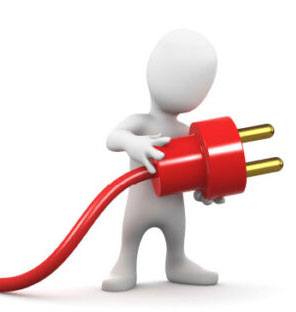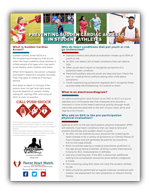What is Sudden Cardiac Arrest?
Sudden Cardiac Arrest (SCA) is a life-threatening emergency that occurs when the heart suddenly stops beating. It strikes people of all ages who may seem to be healthy, even children and teens. When SCA happens, the person collapses and doesn’t respond or breathe normally. They may gasp or shake as if having a seizure. SCA leads to death in minutes if the person does not get help right away. Survival depends on people nearby calling 911. starting CPR. and using an AED as soon as possible.
Sudden Cardiac Arrest
Versus
Heart Attack
THEY ARE NOT THE SAME
Sudden Cardiac Arrest Victim
Heart Attack Victim
Electrical malfunction causes the heart to suddenly and unexpectedly stop beating
Can happen at any age, including children and teens
Person is unresponsive and NOT breathing
Person may gasp or shake, as if having a seizure
Call 911
People nearby must start CPR immediately to triple chance of survival
The use of an AED is the only way to restart a heart; AEDs can be used by anyone
Blockage in the coronary arteries interrupts blood flow to the heart
Happens mostly in people over age 35
Person is responsive and breathing
Person may experience chest, neck or left arm pain, shortness of breath, sweating or nausea
Call 911
Responsive victims don’t need CPR/AED
Doctor will determine appropriate medical treatment
Source: Parent Heart Watch (PHW) is the national voice protecting youth from Sudden Cardiac Arrest (SCA) and preventable Sudden Cardiac Death (SCD). Parent Heart Watch leads and empowers others by sharing information, educating, and advocating for change. JCWWP thanks PHW for their SCA, SCD information, resources, and advocacy.
Why do heart conditions that put youth at risk go undetected?
- Standard history and physical evaluation misses up to 90% of youth at risk
- An EKG can detect 2/3 of heart conditions that can lead to SCA
- Often youth don’t report or recognize symptoms of a potential heart condition
- Parents/Guardians assume youth are okay and just “check the box” on medical forms without asking their child about symptoms
- Youth experiencing symptoms regularly don’t recognize these as potentially life-threatening-it’s normal to them
What is an electrocardiogram?
An electrocardiogram (also known as an EKG or ECG) is a quick, painless and noninvasive test that measures and records a moment in time of the heart’s electrical activity through small electrode patches attached to the skin of your chest. arms and legs by a technician.
Why add an EKG to the pre-participation physical evaluation?
Adding an EKG to the pre-participation physical evaluation (PPE) will identify most heart conditions that can lead to SCA and prevent disabilities and sudden death in youth.
- An EKG can be ordered by your physician for screening for heart disease or for a variety of symptoms or a family history of heart disease and will generally be paid for by insurance (ICD 10-CM Code Z03.89).
- EKGs should be read by a medical practitioner proficient in the age group being screened, utilizing current International Criteria for ECG Interpretation in Athletes.
- Like any screening test. if the EKG is abnormal. additional testing and consultation should be done before a diagnosis is made.
- One screening using EKG does not clear the student-athlete for life.
- EKGs should be performed at regular intervals combined with cardiac risk assessment for new symptoms or relevant family history.
What are the risks of practicing or playing after experiencing any warning sign or symptom?
By continuing to practice or play without seeking medical attention you risk suffering sudden cardiac arrest. which without immediate action by people nearby could result in death or brain damage. Survival rates are under 10%.
What if student-athlete is diagnosed with a heart condition that puts him/her at risk for SCA?
- Your medical provider will inform you of the recommended treatment plan. which could include taking medication. making lifestyle modifications to reduce risk (which sometimes means refraining from competitive sports). surgery to correct the issue. or implantable devices that monitor or treat your heart rhythm.
- You will need clearance in writing from a licensed medical practitioner according to the California Interscholastic Federation bylaws or state laws.
- It’s important to share the student-athlete’s treatment plan with school administration. athletic trainers. coaches or any other leaders. As youth caregivers. they must be aware so they can help monitor your child’s condition.
What are some of the causes of Sudden Cardiac Arrest?
- Congenital (runs in families) disease
- Acquired disease (Kawasaki and others)
- Viral heart infection (myocarditis)
- Heart conditions that result from abnormal heart structure or functions
- An abnormality in the electrical system of the heart
- An impact to the chest directly over the heart, also known as commotio cordis
- Drugs (recreational or prescribed) or stimulants that affect the electrical system of the heart. such as performance enhancing or high-caffeine energy drinks or supplements and diet pills
How common is Sudden Cardiac Arrest?
- SCA affects more than 356,000 people each year in the U.S. including over 7,000 youth under age 18.
- SCA is the #1 killer of student athletes and the leading cause of death on school campuses.
- One in 300 youth has an undetected heart condition that puts them at risk.
What are the warning signs and symptoms?
- Fainting or seizure. especially during or right after exercise
- Fainting repeatedly or with excitement or startle
- Chest pain or discomfort with exercise
- Racing heart. palpitations or irregular heartbeat
- Dizziness or lightheadedness
Excessive. unexpected fatigue during or after exercise - Excessive shortness of breath during exercise
Why does family history matter?
It is important to gather your family history (parents. siblings. grandparents. aunts. uncles. cousins) and share it with your medical provider as some conditions are inherited:
- any family member with heart disease: even if the condition was treated and remedied
- unexplained fainting or seizures
- unexplained sudden death of a family member under the age of 50
Download a free flyer on SCA prevention





